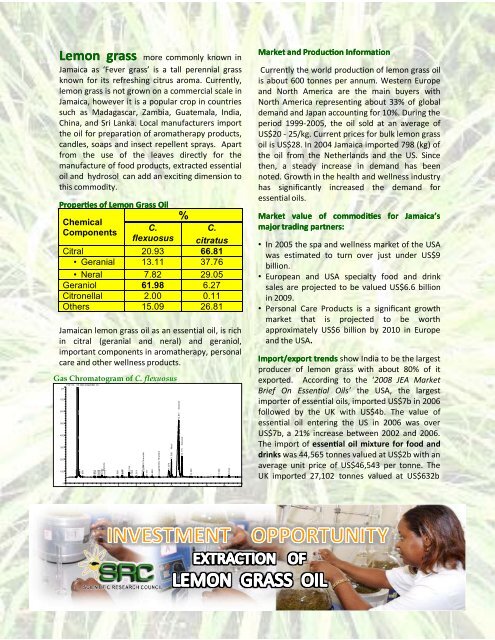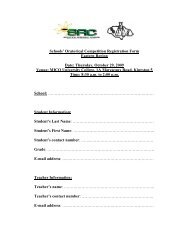Lemon grass - Scientific Research Council
Lemon grass - Scientific Research Council
Lemon grass - Scientific Research Council
You also want an ePaper? Increase the reach of your titles
YUMPU automatically turns print PDFs into web optimized ePapers that Google loves.
<strong>Lemon</strong> <strong>grass</strong> more commonly known inJamaica as ‘Fever <strong>grass</strong>’ is a tall perennial <strong>grass</strong>known for its refreshing citrus aroma. Currently,lemon <strong>grass</strong> is not grown on a commercial scale inJamaica, however it is a popular crop in countriessuch as Madagascar, Zambia, Guatemala, India,China, and Sri Lanka. Local manufacturers importthe oil for preparation of aromatherapy products,candles, soaps and insect repellent sprays. Apartfrom the use of the leaves directly for themanufacture of food products, extracted essentialoil and hydrosol can add an exciting dimension tothis commodity.Properties of <strong>Lemon</strong> Grass OilChemicalComponentsC.flexuosus%C.citratusCitral 20.93 66.81• Geranial 13.11 37.76• Neral 7.82 29.05Geraniol 61.98 6.27Citronellal 2.00 0.11Others 15.09 26.81Jamaican lemon <strong>grass</strong> oil as an essential oil, is richin citral (geranial and neral) and geraniol,important components in aromatherapy, personalcare and other wellness products.Gas Chromatogram of C. flexuosuspA7006005004003002001000FID1 B, (16 909 \SIG20621.D)1.388 1.3211.2051.5741.8983.2103.3543.6723.8354.0924.400 Myrcene5.8886.381 6.4547.3177.1947.5048.0198.7138.807 R&S Citronellal9.1910 2 4 6 8 10 12 14 16 189.80910.595 Gamma Terpineol11.67911.996 Neral12.817 Geraniol13.175 Geranial14.22317.39018.533minMarket and Production InformationCurrently the world production of lemon <strong>grass</strong> oilis about 600 tonnes per annum. Western Europeand North America are the main buyers withNorth America representing about 33% of globaldemand and Japan accounting for 10%. During theperiod 1999-2005, the oil sold at an average ofUS$20 - 25/kg. Current prices for bulk lemon <strong>grass</strong>oil is US$28. In 2004 Jamaica imported 798 (kg) ofthe oil from the Netherlands and the US. Sincethen, a steady increase in demand has beennoted. Growth in the health and wellness industryhas significantly increased the demand foressential oils.Market value of commodities for Jamaica’smajor trading partners:• In 2005 the spa and wellness market of the USAwas estimated to turn over just under US$9billion.• European and USA specialty food and drinksales are projected to be valued US$6.6 billionin 2009.• Personal Care Products is a significant growthmarket that is projected to be worthapproximately US$6 billion by 2010 in Europeand the USA.Import/export trends show India to be the largestproducer of lemon <strong>grass</strong> with about 80% of itexported. According to the ‘2008 JEA MarketBrief On Essential Oils’ the USA, the largestimporter of essential oils, imported US$7b in 2006followed by the UK with US$4b. The value ofessential oil entering the US in 2006 was overUS$7b, a 21% increase between 2002 and 2006.The import of essential oil mixture for food anddrinks was 44,565 tonnes valued at US$2b with anaverage unit price of US$46,543 per tonne. TheUK imported 27,102 tonnes valued at US$632b
with an average unit price of US$23,326 pertonne. Ireland is one of the leading exporters ofessential oil mixtures for food and drink.Processing InformationThe diagram below gives a schematic presentationof oil extraction via distillation. Oil is mainlyobtained through steam distillation of the driedmaterial. The recovery of oil from local driedlemon <strong>grass</strong> is about 0.7 per cent. Hydrosol, a byproductof the process, can be used in cosmetictoiletries and herbal products. Zero wasteprocessing can be realized as the spent leaves canbe used in personal care products, animal feedand compost. Purification of the oil can beachieved by simple filtration. Extraction using thespinning cone column, available in Jamaica,employs a somewhat more sophisticated technology.It is thought to be a very efficientextraction process which can be manipulated toproduce specific profiles .Essential Oil - Steam Distillation ProcessCharacteristics of <strong>Lemon</strong><strong>grass</strong> oilAppearance Clear mobile liquidOdourStrong <strong>Lemon</strong> likeColourPaleY ellowRelative gravity 0.872 – 0.905Refractive index 1.483 1.489Optical rotation 3◦ +1◦Economic InformationOil - A one-acre farm can produce 14.32 kg of oilper harvest. <strong>Lemon</strong> <strong>grass</strong> can be harvested up to4 times per year making it a total of 57.28 kg ofoil per year. Current market price for lemon <strong>grass</strong>oil is US$66 per kg, allows this level of productionto generate (US$66 x 57.28 kg) or US$3,780(J$340,243) at an exchange rate of US$1.00:J$90.00.Hydrosol (floral water) – Simultaneously, the oneacrefarm can produce 13,088 Kg of hydrosol peryear. Current market price for hydrosol is US$3.80per kg, allowing this level of production togenerate (US$3.80 x 13,088 kg) or US$49,734(J$4.48 million) at an exchange rate of US$1.00:J$90.00. An entrepreneur can therefore grossJ$4.8 million from a one-acre farm annually. Highquality commercial lemon <strong>grass</strong> oil is a viableproposition for the small and medium sizedenterprises. Recommended acreage to supportviable economic extraction of oil is 5 acres.DisclaimerThe information presented here is provided for guidance purposes only. Producers of herbal ingredients and of finished consumerproducts that contain herbs are responsible for knowing, understanding, and conforming to all laws and regulations that arerelevant to their businesses, and for implementing practices that may go beyond those described here, as needed. This documentdoes not serve as a substitute for a grower’s or manufacturer’s need to be knowledgeable about the plants which they produce,extract or process. In addition, it does not address all of the needs of those who are producing crops that comply with organicagriculture or other specifically defined agricultural practices. In preparing this document, every effort was made to identifycurrent prices and applications. Guidelines may be revised periodicallyas new information and technology develop.•Tel. (876) 927-1771-4 •Fax (876) 977-1840 •marketech@src-jamaica.org •www.src-jamaica.org<strong>Scientific</strong> <strong>Research</strong> <strong>Council</strong>©2009




